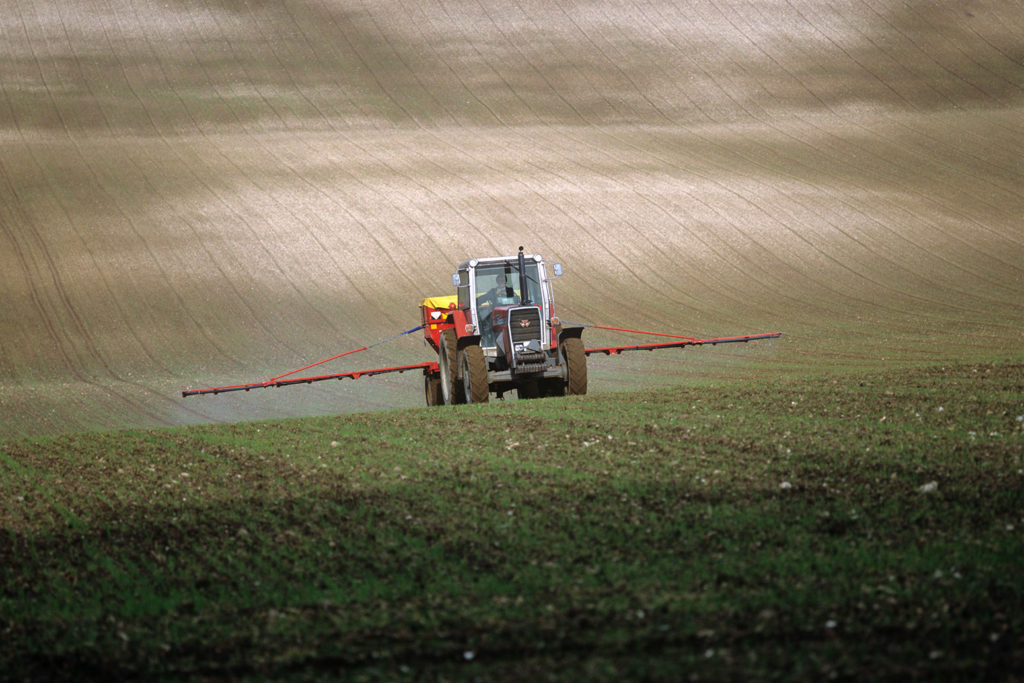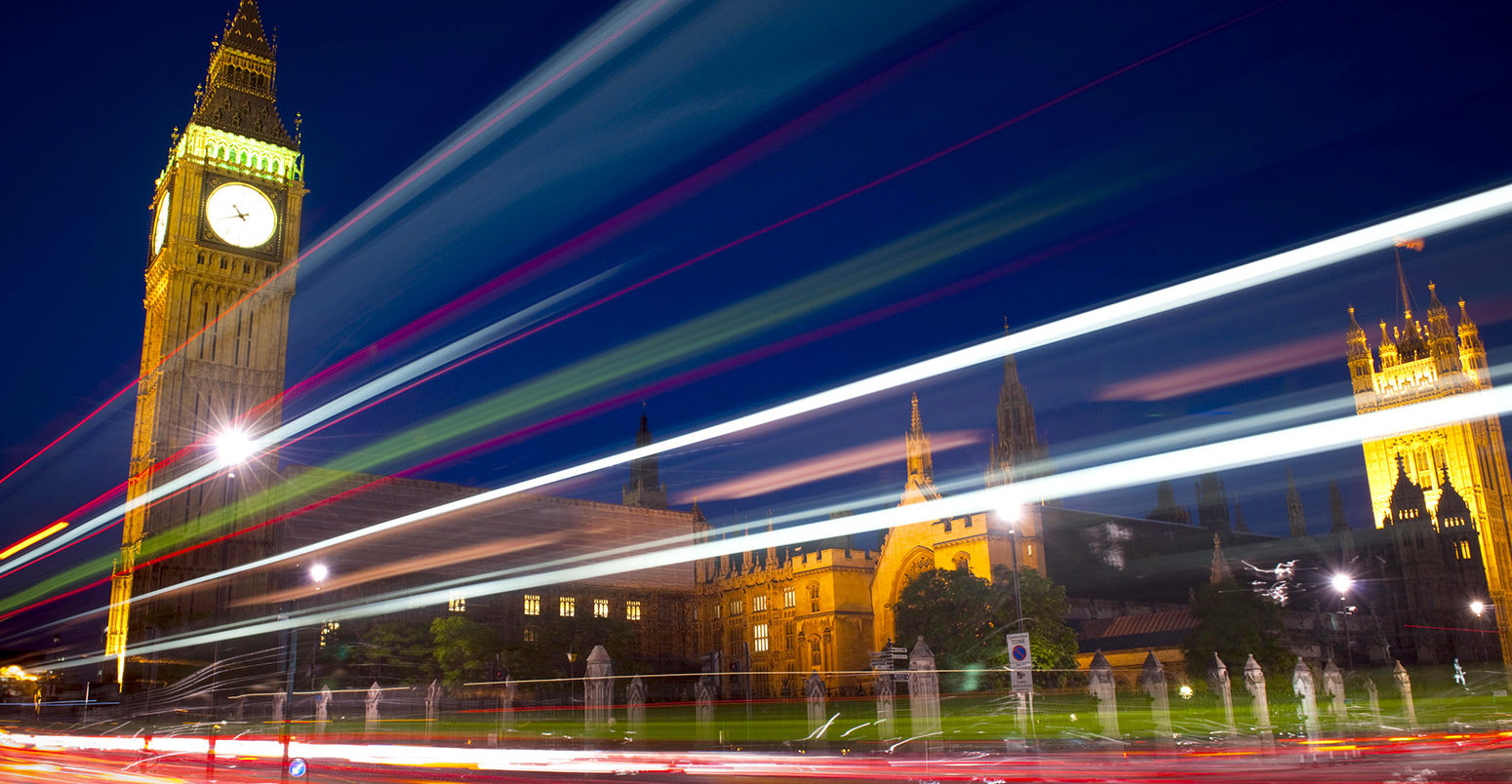
‘Worrying trend’ in UK emission cuts beyond power and waste, says CCC
Jocelyn Timperley
06.28.18Jocelyn Timperley
28.06.2018 | 12:01amProgress in cutting greenhouse gas emissions from the power and waste sectors has “masked the failures in other areas”, says the government’s official climate advisors.
The latest annual progress report from the Committee on Climate Change (CCC), published today, says the UK now faces a much tougher challenge to tackle these other sectors, in order to meet its legally binding climate goals.
Overall, emissions have fallen 43% since 1990, the CCC says, well on the way to the UK’s 2050 target of an 80% cut. However, progress so far has been driven by the power and waste sectors, while emissions from transport, buildings and agriculture have plateaued.
Carbon Brief looks at what the CCC says is now needed from the government to put it back on track to meet its targets.
‘Failures masked’
In January, the CCC assessed the UK’s clean growth strategy, published last October after significant delay.
It said the government’s planned policies fell short of meeting the legally binding fourth and fifth carbon budgets, which together cover 2023 to 2032.
Today’s report has a similar message. Despite some new commitments being made in recent months, such as the pledge to halve new building energy use by 2030, these do not “alter substantially” the previous assessment, the CCC says. “Policy details are still largely absent,” it notes.
Chris Stark, the CCC’s new chief executive, tells Carbon Brief the committee does not think “things are on track” at the moment.
Instead, a “fully fleshed-out programme of policy” is now required, which takes the UK “decisively into committed emissions reduction programmes”, the CCC says. This should cover areas such as: road transport; land use and agriculture; carbon capture and storage (CCS); and improved energy efficiency and low-carbon heat in buildings. The report adds:
“Failing to do so will set the UK on a path to miss its legally binding carbon budgets and store up unnecessary costs for the future.”
Speaking to journalists at a briefing ahead of the report’s, Lord Deben, chair of the CCC, said that now the government has its “story” right, meaning the Clean Growth Strategy, it now has to actually implement it. “This report makes it very clear that the government isn’t doing [that],” he said.
Policy risk
The chart below, from the report, outlines the risk the CCC considers to exist around current policies to meet the UK’s carbon budgets.
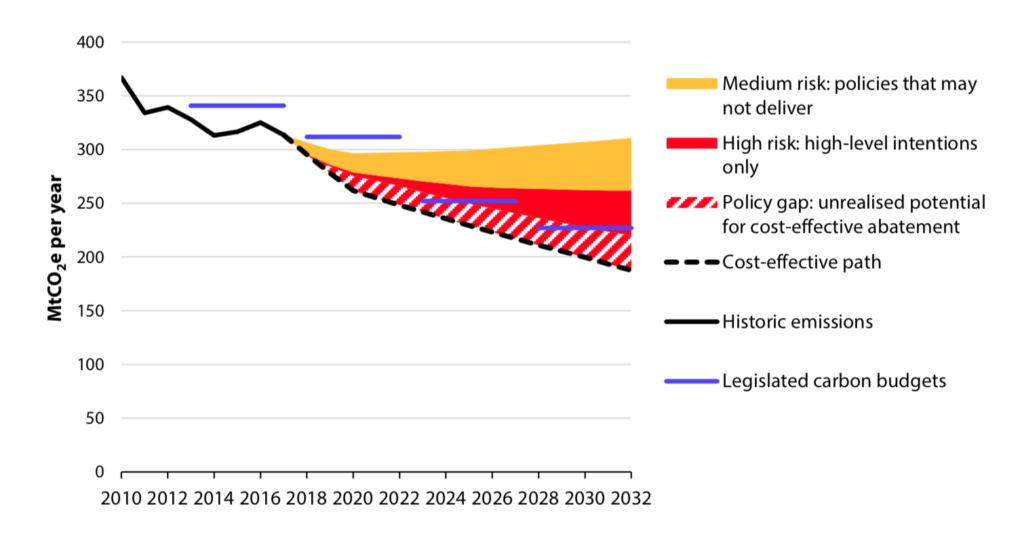
Risks to delivery of policies to meet the UK’s fourth and fifth carbon budgets. The chart presents only sources of emissions not covered by the EU Emissions Trading System (EU ETS) as these determine whether or not a carbon budget is met. Source: CCC 2018
The black lines show the UK’s historic emissions, while the dashed black lines show the cost effective path to meeting the UK’s 2050 emissions commitment. The second, third, fourth and fifth carbon budgets are represented by the horizontal blue lines from left to right. The yellow wedge of the chart shows policies which are in place but which the CCC assesses at medium risk of not being delivered. The red wedge shows where the government has announced an ambition but has no policy in place to meet it. The dashed red wedge shows a “policy gap” to the cost-effective path, which outperforms carbon budgets.
The lines representing the fourth and fifth carbon budgets are clearly both within the “high risk” and “policy gap” areas.
As the chart shows, the CCC’s best estimate of the least-cost pathway to meet its commitment is now beneath the emissions reductions required to meet the fourth and fifth carbon budgets. The CCC says:
“Revisions to our analysis and changes in the baseline mean that the best estimate of the cost-effective path has now dropped beneath the level of emissions required to meet the fourth and fifth carbon budgets. Aiming for this lower path still makes sense.”
Stark says the CCC has moved to being more “obvious” in its assessment of risk. He tells Carbon Brief:
“There’s too much risk attendant to the policies that are in place, or are on course to be delivered. The ambitions that are contained in the Clean Growth Strategy, while we welcome them, generally don’t have policy attached to them yet…
“It would be improbable, I think, if government could remove entirely all that risk. They will definitely need some contingency, and we are not seeing great steps towards achieving that.”
It is worth emphasising, adds Stark, that meeting these carbon budgets is a legal obligation for the government. “It is a law,” he says. “It’s worth having that in mind.”
The CCC also published a chart, below, which shows just how far emissions reductions in recent years have been driven by the power and waste sectors.
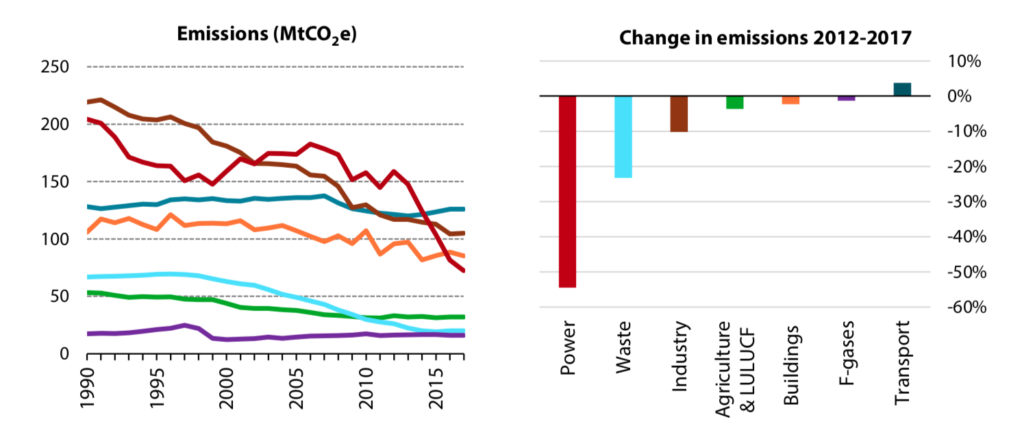
Left: Emissions reductions from 1990 to 2017. Right: changes in sectoral emissions between 2012 and 2017. 2017 are provisional estimates and assume no change in non-CO2 emissions from 2016. Source: CCC 2018
The CCC notes that only power and fluorinated greenhouse gases (f-gas) emissions fell in 2017, while emissions in the industry, buildings and waste sectors increased and emissions in transport and agriculture were flat. “This is now an acute concern – progress in the last five years has effectively stalled,” it says.
The progress report highlights four key “messages” to government over the action it thinks is needed:
-
- “Support the simple, low-cost options” – The government is not supporting low-cost, low-risk options to reduce emissions, such as onshore wind, home insulation and woodland creation, the CCC says.
-
- “Commit to effective regulation and strict enforcement” – Tougher long-term standards are needed, it adds, in areas like road transport and buildings, while regulations must also be enforced to be effective.
-
- “End the chopping and changing of policy” – The abrupt cancellation of important schemes such as the Zero Carbon Homes and the £1bn CCS programme has led to uncertainty, the CCC says. A lack of a consistent policy environment carries a “real cost” in terms of investor risk and business confidence, it adds.
-
- Act now to keep long-term options open – The government must show it is serious about future use of new national infrastructure, such as carbon capture, zero-carbon transport, hydrogen and electrification of heat, the CCC says. The deeper emissions reductions implied by the Paris Agreement make these developments even more important.
For the first time, the CCC has included a list of policy milestones for the next year in its report, which it says it expects the government to meet. Stark tells Carbon Brief: “That is us holding their feet to the fire more actively that we’ve done before.”
Some of the milestones are highlighted in the sections below; see the bottom of article for the full table.
Power
The power sector is the “good news” of the report, says Lord Deben. Three-quarters of emissions cuts since 2012 have come from the power sector and emissions from electricity generation are down by 59% since 2008.
At the same time, the economy has grown by 70%, says Lord Deben, while the 85% of people who are on dual tariffs have seen their monthly bills fall by £20.
However, the CCC notes that reducing emissions in electricity generation is “one of the simpler challenges for policy”. It adds:
“The UK’s continued claim for climate change leadership now rests on continuing the reduction in power sector emissions, while making new commitments at a similar scale in other sectors.”
The CCC is also particularly forceful on the need for the government to provide a route to market for onshore wind, which is the cheapest source of new electricity generation. Speaking at the briefing, Lord Deben said:
“Why on earth are we not allowing those who want to have onshore wind to have onshore wind? What’s the argument that you don’t allow it, even for communities that want to have it?…It is extremely difficult to understand why the government continues with this refusal.”
Speaking to Carbon Brief, Stark says the CCC are now “leaning heavily” on government to give a route to market for onshore wind.
“The harder-edged lesson that we’re delivering is that if government chooses not to pursue something that’s simple and cheap like onshore wind, then it should be very clear what the cost of that is. Presumably they are pursuing something that has a higher cost, and the consumer should know.”
Lord Deben was also asked by journalists about the government’s decision this week to throw out plans for a tidal lagoon project at Swansea Bay. He said:
“You don’t prove your commitment to green energy [by doing] everything that anybody thinks is a good idea…It is really a matter of deciding if it’s cost effective and the government has decided that it isn’t cost effective.”
Transport
The CCC says it is “disappointed” that the government’s “Road to Zero” transport strategy, expected by March 2018, has not yet been published. It clearly states in the report that current government’s ambitions in this area are not enough to meet the fourth and fifth carbon budget.
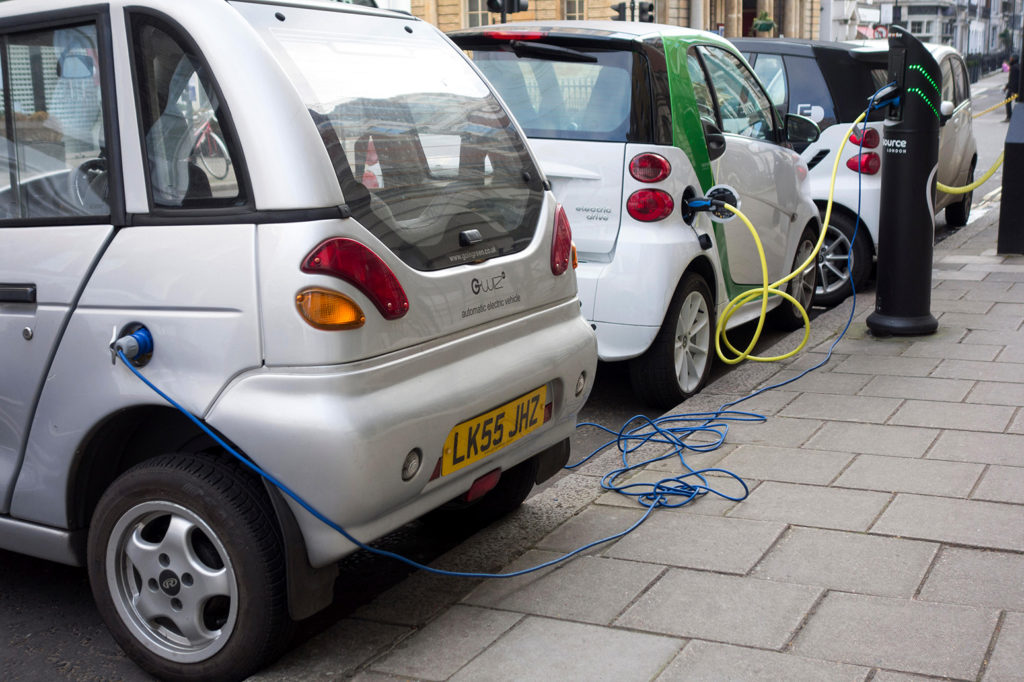
Electric vehicles plugged into charging points on a road in London, UK. Credit: CAMimage / Alamy Stock Photo.
Writing in the foreword to the progress report, Deben notes: “With each delay, we stray further from the cost-effective path to the 2050 target”.
Speaking at the briefing, Lord Deben said the CCC considers the government’s current target to ban the sale of pure diesel and petrol vehicles from 2040 needs to be moved closer to 2030, with a public programme to support this. He added:
“The Department for Transport (DfT) has all the resources; if, in fact, it doesn’t move to that, it may be that the CCC is going to have to make some more detailed proposals.”
Since the CCC was unable to assess the “Road to Zero” transport strategy in the progress report, Stark tells Carbon Brief it will now assess it in a separate, standalone report once it is published.
Aviation
Earlier this month, Lord Deben and CCC deputy chair Baroness Brown wrote to transport secretary Chris Grayling expressing “surprise” at his failure to mention climate change when announcing government backing for the controversial third runway at Heathrow.
The letter made clear the CCC “does not have a view” on the location of airport capacity, as long as total UK aviation emissions are compatible with meeting the 2050 climate objectives.
Despite some media reports to the contrary, today’s new report does not present any new views on aviation. However, it does ask the government to ensure its upcoming aviation strategy, due for publication in 2019, includes a plan to limit aviation emissions to around 2005 levels by 2050. This is what was assumed when the fifth carbon budget was set, the CCC says.
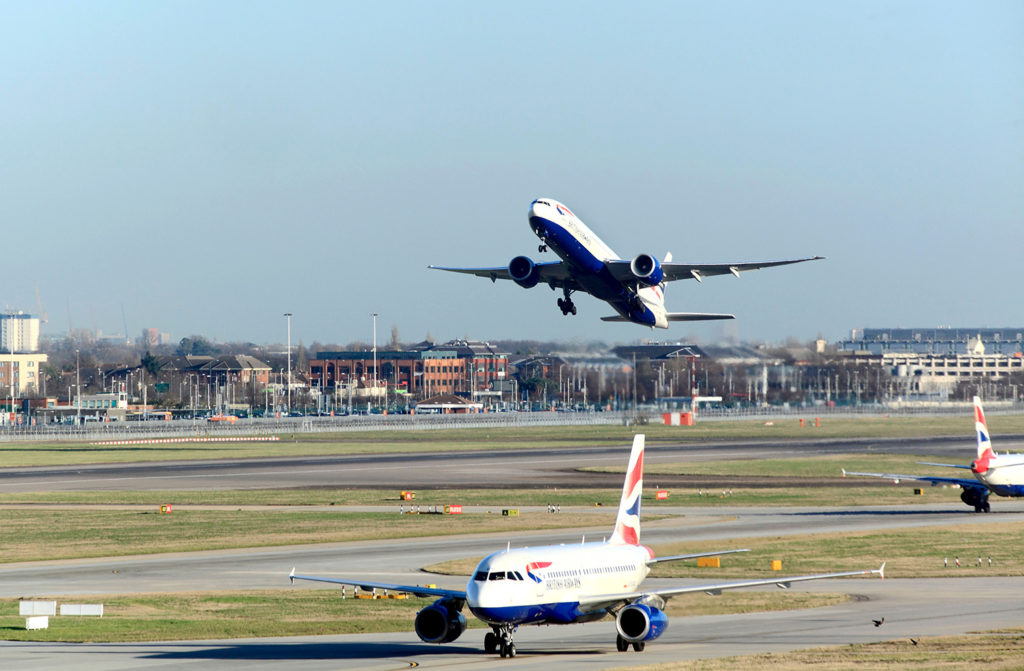
Boeing 767 takes off at Heathrow Airport runway. Credit: Peter Phipp/Travelshots.com / Alamy Stock Photo.
Lord Deben made it clear that the committee stands firm that this emission cap should not be exceeded. “There is absolutely no more space for aviation,” he said, since this would mean even tougher targets for other sectors. He said:
“I am saying absolutely clearly, without any questions, aviation cannot break these parameters. Nor can it cover up a break by using either so-called flexibility or by buying offsets somewhere else because that’s not going to be possible. And the budget is written on the basis that this is by direct national action.”
Lord Deben added that the government’s commitments in Paris may mean a pressure to implement a tougher target for aviation emissions. Aviation currently has a “pretty generous share from the overall”, he said. The UK’s current climate targets are based on limiting warming to 2C, while the Paris climate deal set a higher ambition of staying “well below” 2C and striving for 1.5C.
The UK government has long accepted the need to set a net-zero goal “at an appropriate point in the future”. Earlier this year, it said it wants official advice on the “implications” of aligning its climate goals with the Paris Agreement. Carbon Brief analysis has shown aviation could consume around half of the UK’s 2050 carbon budget for 1.5C, even if emissions are kept within the CCC’s limits.
The CCC is set to deliver a new report on aviation in early 2019 to inform the UK’s upcoming aviation strategy. The last CCC report to focus solely on the sector was published in 2009.
Buildings
Alongside transport, housing is the other key area highlighted by the CCC as in strong need of new policies. Speaking at the briefing, Lord Deben said it was “ridiculous” that the UK is building houses which are not meeting the highest energy efficiency standards.
He added that the failure of the government to change those standards and its expression of only having a “mission” to do it by 2030 is “just neither urgent enough nor sensible enough to deliver”.
The CCC’s list of new policy measures which need to be taken in the next year (see below) is particularly long for the building sector. In particular, it calls for the promised successor to the Renewable Heat Incentive (RHI) to be decided upon this year.
It also asks the government to publish “concrete policies” to deliver on its ambition to retrofit as many homes as possible to Energy Performance Certificate (EPC) band C by 2035.
Agriculture
The CCC notes the “heartening” new prominence given to environmental protection by Department for Environment, Food and Rural Affairs (Defra).
However, it says: “We need this enthusiasm to stretch into reducing carbon from agriculture and land use.” Risks to existing policy commitments on reducing emissions from agriculture continue to be too high, it adds.
Voluntary, industry-led measures to reduce greenhouse gases from agriculture “don’t appear to be working now”, Stark tells Carbon Brief. A stronger replacement framework should take effect from early 2019, the report says.
The CCC is particularly keen to consider measures to improve agriculture’s climate contribution after the UK leaves the EU Common Agricultural Policy (CAP), it says. The report says the 2018 Agriculture Bill should link financial support to farm emissions reduction and carbon sequestration by 2022.
Meanwhile, the government “really has to get its tree-planting policy to work”, said Lord Deben at the briefing. The government has committed to plant 11m trees in England between 2017 and 2022, but the CCC says this rate is two-thirds lower than it needs to be to achieve this. The government should ensure it removes non-financial barriers to rapid afforestation this year, the CCC says.
The CCC and its adaptation sub-committee are set to publish a report on the future of land use later this year. The CCC is also planning a future report looking in more depth at agricultural issues. These will incorporate both mitigation and adaptation aspects, Lord Deben said:
“We are going to do some very significant work on land use, the 25 Year [Environment] Plan of Defra clearly is not specific enough in lots of areas and we’re going to have to try to help them put that right.”
It is worth noting that the government’s second National Adaptation Programme is also due to be published later this year.
Looking forward
The CCC has set out a list of policy actions it considers government needs to deliver before the committee’s next progress report is published in June 2019. These are set out in the table below.
Particularly of note (but not mentioned above) is the request for a new Waste Resource Strategy, due later this year. The CCC says this needs to set commitment to banning food waste from going to landfill by 2025, as it generates methane.
Meanwhile, by summer 2018, the government needs to translate its ambition to improve business energy efficiency by 20% into “specific, concrete and measurable policies with clear timings and outcomes”.
Finally, the government’s promised CCS Deployment Pathway, also set to be published in 2018, must be consistent with having the first CCS cluster operational by 2026, the CCC says.
-
‘Worrying trend’ in UK emission cuts beyond power and waste, says CCC
-
UK still ‘not on track’ to meet emissions targets, says CCC
-
UK ‘must learn lessons of last decade’ to meet climate targets, says CCC



